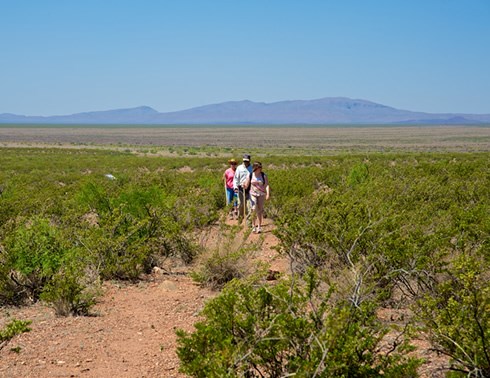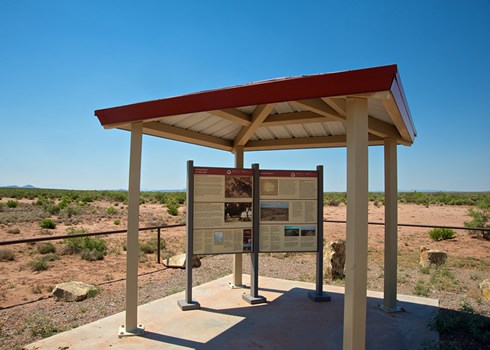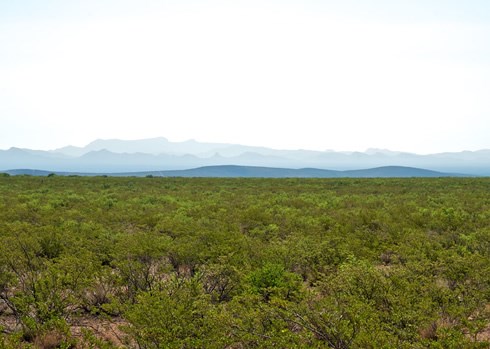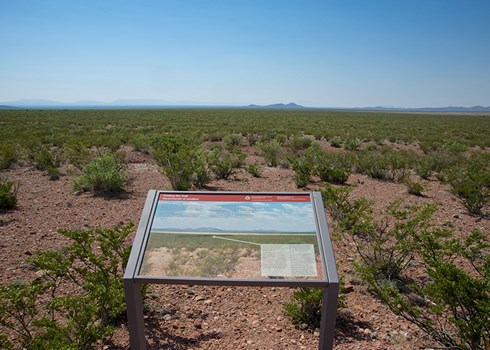Last updated: July 2, 2020
Article
New Mexico: Yost Draw

Somewhere along the meandering 1 ½-mile interpretive path that follows parts of El Camino Real de Tierra Adentro to Yost Draw, a visitor may begin to wonder what he or she is doing in the middle of the Jornada del Muerto—the Journey of the Dead Man.
This parched and perilous section of El Camino Real spans 90 miles of desert where, in 1670, German trader Bernardo Gruber died of exposure after escaping a Sandia Pueblo prison. Gruber had been charged with practicing witchcraft by the Office of the Holy Inquisition, but he faced his final trial attempting to cross the desert. The decomposing remains of Gruber and his horse were reportedly found just beyond the escarpment at the northernmost point of Yost Draw, at a site now known as La Cruz del Alemán (The Cross of the German). The incident reportedly inspired the Jornada del Muerto’s ominous name.
Though only 20 miles from Interstate-25, Yost Draw’s off-the-beaten-track locale and quiet emptiness can indeed feel ominous when one realizes that, even in the 21st century, trekking through the desert is no walk in the park. Yet for anyone who wants to understand the mind-boggling challenges and triumphs that characterize El Camino Real, and the determined motivations of countless thousands who over 300 years dared to cross the Jornada del Muerto, the historical and experiential significance of Yost Draw is too compelling to miss. Just as soon as a visitor's high-performance hiking boots connect with the tired footsteps of El Camino Real travelers on the very ground they trod, one becomes part of the living history of the trail.
Set between the Caballo and San Andres mountains, the route through the Jornada del Muerto was forged as a shortcut that could take days of travel off the more difficult Rio Grande course. As the longest waterless stretch of El Camino Real between El Paso del Norte and Santa Fe, the journey demanded the stamina of travelers and livestock to endure three thirsty days without firewood or forage in often sweltering heat while hauling weighty wagon loads. Wayfarers prayed for thunderstorms and hoped for starlight to guide their travel at night so they could avoid crossing in the heat of day. They also prayed for protection from frequent Apache or Navajo attacks. Parajes (rest stops), such as San Diego to the south and Fray Cristóbal on the north, provided respite and refreshment on either side of the journey—but only to those who survived.

Despite the risks, the Jornada del Muerto was for three centuries a main thoroughfare of trade and transportation between Mexico and New Mexico and the only track for moving heavy freight until the arrival of the railroad in the 1880s. Spanish explorer Juan de Oñate first used the shortcut on his journey north to found the New Mexico province in 1598. Government officials, soldiers, priests, traders, mail carriers, settlers and others who came to New Mexico throughout the Spanish colonial, Mexican and Territorial periods also braved the way.
Traversing nearly 3.8 miles of the Jornada del Muerto, the Yost Draw section of El Camino Real today is one of the best-preserved portions of the trail. Its clearly defined pathways, deep arroyos and variations in vegetation convey a uniquely unchanged picture of the trail through time. Parallel roadways reveal where new paths were developed as others on the steep slope overlooking Yost Draw eroded. Cobblestone ramps, battered after centuries of heavy traffic, demonstrate innovative road improvement methods that provided livestock and wagons better footing through steep climbs and descents. Occurrences of artifacts, from Spanish colonial ceramics to grinding stones to U.S. Army-issued tin cans, point to Yost Draw campsites and resting points used by centuries of trekkers.
A short climb east on the interpretive trail brings hikers to an overlook from where the trail’s south-north path comes into view. Giant yucca and overgrown mesquite mark a dark stripe of trail as it emerges from the south. As the eye moves northwest toward the Yost Escarpment, dense vegetation gives way to subtle swales and clear stretches of roadway. The musky smells of mesquite, tarbush and creosote fill the air as one steps gently down the sandy path of the escarpment where countless thousands of footsteps, horse hooves and wagon wheels have passed.

It’s easy to let one’s imagination get carried away in the desert. One wonders whether any of the hundreds who perished in the desert heat from illness, injury, or Indian attack ever stood in the spot where one now stands. But with the convenience of bottled water, GPS and a well-marked trail with informative bilingual interpretive wayside exhibits, the moderate climb to the escarpment rim is probably safer than a drive on Interstate-25.
Reaching the escarpment edge, the reward for leaving one’s comfort zone to experience one of the most scenic and thrilling sections of El Camino Real is clear. Amidst the sweeping views from atop the steep and rocky slope is the strange sight of the futuristic Spaceport America, the new hub of commercial space travel. While the Spaceport makes a powerful statement about how transportation has evolved through time, the more interesting statement is imprinted in the landscape to the north. As El Camino Real continues its confident course through the Jornada del Muerto, past La Cruz del Alemán and up the long corridor beyond, we see that the clearest path to modernity is history.
The Yost Draw trailhead is located on Sierra Country Rd. A013, near Truth or Consequences, NM. For more information, visit the National Park Service El Camino Real de Tierra Adentro website.
Explore more history by visiting the El Camino Real travel itinerary website.

